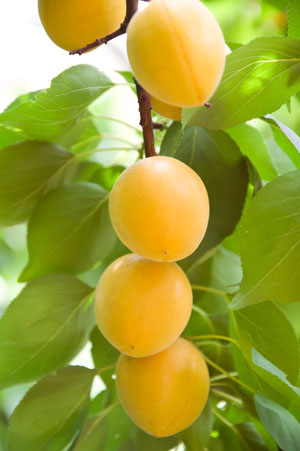Prunus armeniaca
|
Overview
 Germplasm
Page of 19 Libraries
The following libraries are associated with this organism.
Genomes
Description
Apricot (Prunus armeniaca) is highly prized for its fresh and dried fruit flavor characteristics. Apricots have been traced to China, as early as 658 B.C. Due to their early bloom and precocious nature, apricot production is limited to areas with moderate to cold winters that are frost-free during the spring with hot summers. Apricots are diploid (2x) and can be grafted with plum and peach. Leaves are ovate with a rounded base, serrated margins, and pointed tips. Flowers may be white or pink and emerge from previous year’s lateral buds before leaves emerge. The fruit have a large pit, with flesh mostly yellow or light in color with varying amounts of red or orange blush on the skin. Fruit do not typically contain much juice. Botanical varieties of apricot include Siberian apricot (P. armeniaca var. sibirica Koch), Manchurian apricot (P. armeniaca var. mandshurica Maxim.), Ansu apricot (P. armeniaca var. ansu (Maxim.) Kost.), Japanese apricot (P. mume), alpine plum (P. brigantica Vill.), purple or black apricot (P. dasycarpa Ehrh), and Tibetian apricot (P. holocericea Batal.). Although the name of cultivated apricot (Armenian apricot, P. armeniaca) appears to indicate an Armenian origin, details of its first cultivation are unknown. Apricot are typically grafted onto peach or plum rootstocks to withstand various nematode and fungal pathogen pests and impart soil pH and texture adaptability. Apricot trees are susceptible to bacterial canker and blast (Psudeomonas syringae) for which there are few effective control methods other than incorporating disease resistance into new cultivars. Trees are also susceptible to various fungal diseases including shothole (Wilsonomyces carpophilus), powdery mildew (Sphaerotheca pannosa and Podosphaera tridactyla), Armillaria root rot (Armillaria mellea), and virus diseases such as plum pox (Plum pox virus; several strains). Apricot fruit are susceptible to blossom blight and fruit brown rot (Monilinia laxa), reducing availability of fresh fruit in the marketplace. |
